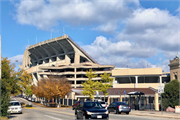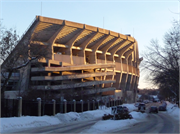| Additional Information: | A 'site file' exists for this property. It contains additional information such as correspondence, newspaper clippings, or historical information. It is a public record and may be viewed in person at the Wisconsin Historical Society, State Historic Preservation Office.
2014 North Addition is called the Stephen M. Bennett Student-Athlete Performance Center.
City of Madison, Wisconsin Underrepresented Communities Historic Resource Survey Report:
The University of Wisconsin’s Athletic Department and its football team have been historically willing to integrate their team and were often at the forefront nationally in the process of encouraging diversity. The first Black football player with the University of Wisconsin Badgers football team was Leo Butts, who played beginning in 1918. However, the school did not record the race of its students and players until 1940, so it may not be precise.
Edward Withers, Jr. was born in Memphis, Tennessee in 1926 and moved to Madison with his family as a young boy. He lived in a non-extant apartment located at 754 West Washington Avenue. Eddie graduated from Madison’s old Central High School in 1944. After serving in the United States Army towards the end of World War II, he received his discharge in 1947 and enrolled at the University of Wisconsin-Madison. He started on the Badgers football team during his freshman year in 1947 but was ineligible to play during his second year in college. Withers returned to the field in 1949 as starting defensive halfback, a position he would keep for the next three years. Withers was considered an integral part of Wisconsin’s defense, which outscored their opponents with no offensive help for two years. The team won the Big Ten title in 1952, securing their first trip to the Rose Bowl, where they lost to the University of Southern California. While Withers was not the first Black man to participate in the University of Wisconsin-Madison athletics, he was arguably the most recognized, being the first to garner national attention as a college football All-American in 1952.
Eddie married his wife Alita and had a son in 1951 while still a student, earning him the nickname among his teammates and fans of “Pop” and lived in Madison for a short time in a non-extant apartment located at 5 South Mills Street in the Greenbush neighborhood.
Withers played and practiced along with student-athletes of all races and backgrounds in Camp Randall Stadium on the University of Wisconsin-Madison campus. The large football stadium, located at 1440 Monroe Street, was constructed in 1916, with significant additions, alterations, and expansions in 1923, 1940, 1950, and 1965. The same site, before the 1920s, was also used as the university’s playing fields and athletic track.
Wither’s performance in college attracted the attention of the Green Bay Packers, who drafted him in 1952; however, his pro football career was cut short when he was waived towards the end of training camp the following year. Wither’s lived the rest of his life in Milwaukee and died in 1975. After his death, the Madison chapter of the NAACP wrote to The Capital Times urging that Wither’s contributions be recognized, and two years later Withers was named to the Madison Sports Hall of Fame in 1977. Withers was added to the University of Wisconsin-Madison Athletics Hall of Fame in 1992. Since then the University of Wisconsin-Madison Athletic Department has made a conscious effort to celebrate the history of African Americans at the university and in college athletics generally. |
|---|
| Bibliographic References: | University of Wisconsin-Madison: Update to the Preliminary Evaluation of Buildings and Structures for Eligibility for the National Register of Historic Places, June 13, 2023.
University of Wisconsin-Madison: Preliminary Evaluation of Buildings and Structures for Eligibility for the National Register of Historic Places. September 2009.
Feldman, Jim. “Buildings of the University of Wisconsin.” Madison, WI : UW Madison, Archives and Records Management Service, 2006. Originally published 1997. http://madcat.library.wisc.edu/cgi-bin/Pwebrecon.cgi?BBID=7134919. Accessed: February 2012.
University of Wisconsin-Madison, Office of Public Information, University of Wisconsin-Madison Tour Guide: South Campus, 1989. |
|---|




